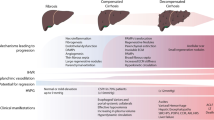Summary
It has been demonstrated that serotonin (5-hydroxytryptamine; 5HT) can decrease portal vascular resistance in animals and could be a possible mediator for intestinal vasodilation. Moreover, isolated mesenteric vein from portal hypertensive rats has been shown to be hyper-responsive to 5HT. Hence 5HT may play a role in the pathophysiology of the hyperkinetic syndrome observed in patients with portal hypertension. This hypothesis that serotonin might increase splanchnic blood flow, and hence portal pressure, led us to propose that 5HT receptor antagonists might decrease portal hypertension. We observed that acute administration of ketanserin, an antagonist of serotonin at 5HT2 receptors, significantly decreased portal pressure and portal-systemic collateral blood flow in patients with cirrhosis, whereas hepatic blood flow was not modified. Arterial pressure slightly decreased, while cardiac output was not affected by ketanserin. These findings were also observed during continuous administration of ketanserin. More recently, it has been shown that ritanserin, a more specific 5HT2 receptor antagonist, significantly decreased portal pressure in cirrhotic patients. Finally, in rats with portal hypertension, ketanserin as well as ritanserin produced significant reductions in portal pressure but did not modify portal tributory blood flow. In these portal hypertensive animals, 5HT2 antagonists may act on hepatocollateral vascular resistance. These studies confirm current evidence in favor of a role for the actions of serotonin via 5HT2 receptors in portal hypertension and add a new group of substances for its treatment.
Similar content being viewed by others
References
Richardson PDI, Withrington PG, Responses of the simultaneously-perfused hepatic arterial and portal venous vascular beds of the dog to histamine and 5-hydroxytryptamine. Br J Pharmacol 1978;64:581–588.
Schrauwen E, Houvenaghel A. Effect of 5-hydroxytryptamine on mesenteric hemodynamics in the pig. Arch Int de Pharmacodynam et de Thérap 1980;246:257–263.
Grönstad KO, Dahlström A, Jaffe BM, Ahlman H. Regional and selective changes in blood flow of the feline small intestine induced by endoluminal serotonin. Acta Physiol Scand 1986;127:207–213.
Cummings SA, Groszmann RJ, Kaumann AJ. Hypersensitivity of mesenteric veins to 5-hydroxytryptamine and ketanserin-induced reduction of portal pressure in portal hypertensive rats. Br J Pharmacol 1986;89:501–513.
Gasic S, Eichler HG, Korn A. Effect of ketanserin on phenylephrine-dependent changes in splanchnic hemodynamics and systemic blood pressure in healthy subjects. J Cardiovasc Pharmacol 1985;7:219–223.
Kaumann AJ, Morgan JS, Groszmann RJ. ICI 169,369 selectively blocks 5-hydroxytryptamine2 receptors and lowers portal pressure in portal hypertensive rats. Gastroenterol 1988;95:1601–1606.
Mastai R, Giroux L, Semret M, Huet PM. Mechanism of ritanserin-induced decrease in portal pressure in conscious and unrestrained cirrhotic rats. Hepatology 1988;8:1245.
Koshy A, Sekiyama T, Hadengue A, Cerini R, Girod C, Lebrec D. Effects of different vasoactive substances on portal-systemic collateral vascular resistance in conscious portal hypertensive rats. Hepatology 1988;8:1344.
Mastai R, Rocheleau B, Huet PM. Serotonin blockade in conscious, unrestrained cirrhotic dogs with portal hypertension. Hepatology 1989;9:265–268.
Hadengue A, Lee SS, Moreau R, Braillon A, Lebrec D. Beneficial hemodynamic effects of ketanserin in patients with cirrhosis: Possible role of serotonergic mechanisms in portal hypertension. Hepatology 1987;7:644–647.
Deflandre J, Pirotte J, Etienne M, Carlier J. Effects d'un antagoniste des récepteurs S2 de la sérotonine sur l'hypertension portale de la cirrhose. Résultats préliminaires d'une étude hémodynamique cardiaque et hépatique. Annales de Gastroentérol et d'Hépatol 1988;24:103–105.
Vorobioff J, Garcia-Tsao G, Groszmann R, Aceves G, Picabea E, Villavicencio R, Hernandez-Ortiz J. Long-term hemodynamic effects of ketanserin, a 5-hydroxytryptamine blocker, in portal hypertensive patients. Hepatology 1989; 9:88–91.
Huet PM, Pomier Layrargues G, Semret M. Effects of ritanserin, a serotonin antagonist, in cirrhotic patients with portal hypertension. Hepatology 1988;8:1422.
Hadengue A, Moreau R, Cerini R, Koshy A, Lee SS, Lebrec D. Combination of ketanserin and verapamil or propranolol in patients with alcoholic cirrhosis: Research for an additive effect. Hepatology 1989;9:83–87.
Author information
Authors and Affiliations
Rights and permissions
About this article
Cite this article
Lebrec, D. Portal hypertension: Serotonin and pathogenesis. Cardiovasc Drug Ther 4, 33–35 (1990). https://doi.org/10.1007/BF00053424
Issue Date:
DOI: https://doi.org/10.1007/BF00053424




